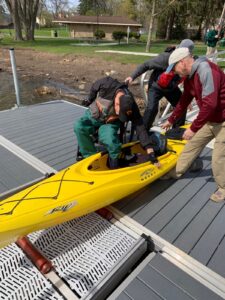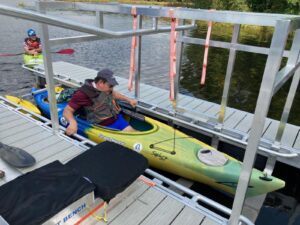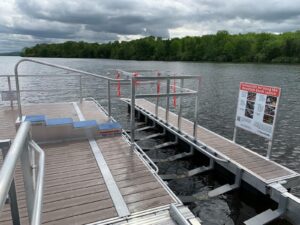
BoardSafe Docks is often asked if rollers will damage a kayak hull. First and foremost, it’s important to understand not all kayak launches are the same, and the BoardSafe Adaptive Kayak Launch does not use rollers on its launch system. BoardSafe uses a supportive saddle and cradle launch for a safe and smooth entry into the water.
History of BoardSafe’s Kayak Launch and its features
BoardSafeDocks developed its Adaptive Kayak Launch after being approached by the Leaser Lake Heritage Foundation, the Kempton Area Lions Club, and an adaptive paddling group, who were using their lake for adaptive paddling events. They were looking to make the lake more accessible to paddlers in wheelchairs who presented themselves with varied needs and paddling abilities. The adaptive athletes and the volunteer group that supported them reported that, more often than not, they struggled to get their paddlers in and out of their kayaks and safely out onto the water.
Working together with them, BoardSafe Docks identified the barriers paddlers were facing and created solutions to gain access to the water using adaptive features that would support their safety and independence.

Rollers on the kayak launch were not part of the solution, and here’s why.
BoardSafe’s Adaptive Kayak Launch was designed with adaptive paddlers in mind for safer and easier access to kayaking vessels. From the perspective of differently-abled paddlers, rollers were not recommended for the following reasons.
- Rollers lack stability for kayakers Roller launches do not hold the vessel steady and lack stability when placing an adaptive paddler in their kayak. Rollers do not provide the same type of support as a cradle launch system. This lack of stability makes it difficult for all paddlers to load and unload, particularly those with mobility limitations, especially in windy or rough water conditions.
- Fulcrum effect When the kayak’s weight is not evenly distributed on the rollers, or if the kayak’s weight is concentrated on a small area of the hull, it can create a pivot point (fulcrum) that places excessive stress on that part of the kayak, potentially causing damage to the kayak. When too much force is applied during the launching or loading process, it can cause the kayak to bend or bow. This force can lead to hull deformation over time. Due to the angle and drop found on roller launches, this launch type can create a point load on kayaks that leads to unintended stress and damage to kayak hulls.
As seen in the picture below, the front of the kayak is elevated, causing stress to the hull. There is no stability offered to the kayaker nor support to prohibit the kayak from tipping over. The width of this particular launch system is 6 feet, too wide to serve any paddlers. Functionality is limited for those who wish to keep their kayak steady, keep their feet dry, and not cause point load stress to their kayak hulls.
One paddler with personal experience with roller launches said, “Without constant maintenance, they soon start to fall apart.” Another kayaker commented, “My kayak became unstable when launching into the water, and the drop put stress on my kayak.”


*Not a BoardSafe Adaptive Kayak Launch*
Kayak launches designed with roller systems should be avoided by users with higher-end kayaks made from fiberglass, kevlar, carbon fiber, and other hard-shelled composite boats. With so many different kayaks and kayak launches on the market, engineers designing launch systems need to become more aware of the unintended consequences that result when advertising these ramps for all kayaks. Most recently, people with higher-end kayaks have reported damage to their kayaks when using roller launches. One paddler with a nearly-new Kevlar boat reported his kayak sustained $700 in damage due to multiple cracks in the gel coat from the rollers and the stress caused by the point load on the roller ramp.
Anyone operating expensive vessels on a roller launch system should use caution—The material of the kayak’s hull plays a significant role, and owners should understand their kayak’s limitations. Kayaks made from materials like fiberglass, kevlar, carbon fiber, and other composites, are more susceptible to damage. Rollers can potentially create pressure points that damage the hulls of more fragile materials. If the rollers are not aligned, padded, or maintained, they can cause scratches, dents, and other damage to the kayak’s hull.
Kayaks that are less expensive and used for recreation, like high-density polyethylene (HDPE) and other durable plastics, are more suitable for launches with rollers. Roller launches typically work fine for plastic-hulled boats; however, keep in mind that roller launches lack the adaptive features necessary to provide access for paddlers in wheelchairs and those with physician limitations.
Problems reported with roller launches
- Misalignment If the kayak is not loaded onto the rollers properly, it can cause the kayak to scrape against the rollers or become misaligned, potentially leading to dents, scratches, or uneven pressure on the kayak’s hull, potentially causing bending or deformation.
- Sharp edges or rough surfaces If the rollers have sharp edges or rough surfaces, they can scratch or gouge the kayak’s hull as it is loaded and unloaded.
- Insufficient padding Some kayak launches have rollers with inadequate padding or cushioning. Without proper padding, the kayak’s hull can suffer from excessive pressure points, leading to damage over time.
- Incorrect positioning Placing the kayak too far forward or backyard on the rollers can cause undue stress on specific areas of the kayak, potentially leading to damage.
- Debris or contaminants stuck to rollers If there are debris, dirt, or contaminants on the rollers, they can scratch or damage the kayak’s hull during the loading and unloading process.
- Low-quality rollers If rollers are made with inferior material or poorly constructed, they may not provide the necessary support and protection, increasing the risk of damage.
Tips to minimize the risk of damage to kayaks when using a roller launch
- Ensure proper alignment Position the kayak evenly on the rollers to distribute the weight evenly and avoid unnecessary stress on any area of the hull.
- Keep rollers clean Regularly inspect, clean, and maintain the rollers to remove debris or contaminants that could scratch the kayak. Regularly inspect the rollers for damage and rough spots and replace them if needed.
- Use additional padding or cushioning material to protect the kayak’s hull.
- Use care and caution when applying force during the launch and loading process.
- Choose an appropriate launch method based on the kayak’s hull material and design.
The most accessible kayak launch
A properly designed kayak launch will have a cradle launch or kayak chute long enough and narrow enough to hold on to both sides until the vessel is fully on the water to alleviate any stress to the vessel. It’s crucial for kayakers to be mindful of potential sources of damage and take precautions to protect their kayak.
BoardSafe Docks takes pride in creating a positive user experience. The comfort and safety offered to our clients, as well as the quality, durability, and sustainability of our products, is a priority to ensure our customers are satisfied with our accessible products.


In summary, rollers on kayak launches can be useful for certain situations, but they are not without their drawbacks. The choice of launch method should include factors such as the kayak’s hull material, the kayaker’s skill level, environmental concerns, and the specific conditions at the launch site. Depending on these factors, alternative launch methods, such as cradle-style launches, may be preferred to minimize the risk of damage to the kayak and ensure a safe and stable launching experience. That is why the BoardSafe Kayak Launch is made with smooth low-friction slides and does not include rollers.
This video demonstrates the necessary adaptive features of a BoardSafe Kayak Launch and its cradle chute with an easy glide entry into the water.
The Most Accessible Adaptive Kayak Launch
For more information about BoardSafe’s Adaptive Kayak Launch, click the link below or contact us at 610-899-0286 or through our website at BoardSafeDocks.com.
https://20491040.fs1.hubspotusercontent-na1.net/hubfs/20491040/E-Brochure-BoardSafe-Kayak-Launch.pdf
